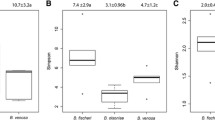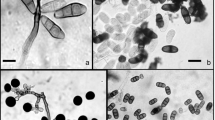Abstract
Endophytic fungi inhabit living plant tissues without causing disease symptoms. Although abundant, the extent of their contribution to fungal biodiversity remains unclear. Since endophytic fungi are poorly known, especially in the tropics, current estimates of fungal species are probably conservative. Here we tested strategies for sampling endophytic fungi in tropical plants. We compared the number of fungi isolated from 400 mm2 leaf pieces that were divided into increasingly small fragments. Leaf pieces were surface-sterilized, cut into fragments and plated on culture media. For a given area, cutting leaf pieces into smaller fragments significantly increased the number of fungal morphospecies recovered. There was a strong linear relationship between size of fragments and number of fungi isolated. By extrapolation, an estimated 16 ± 3 fungi could be recovered from a 2 × 2 cm leaf piece, using infinitely small fragments. This represents a large part of the fungal diversity estimated to exist in leaf endophytes in a population. We conclude that reducing the size and increasing the number of leaf fragments will increase the number of fungal species isolated. This strategy will help to estimate real values of endophytic fungal diversity.
Similar content being viewed by others
References
Abbas JD, Hetrick BAD, Jurgenson JE. Isolate specific detection of mycorrhizal fungi using genome specific primer pairs. Mycologia 1996; 88: 939–946.
Arnold AE, Maynard Z, Gilbert GS, Coley PD, Kursar TA. Are tropical fungal endophytes hyperdiverse? Ecol Lett 2000; 3: 267–274.
Bayman P, Cotty PJ. Vegetative compatibility and genetic diversity in the Aspergillus flavus population of a single field. Can J Bot 1991; 69: 1707–1711.
Bayman P, Lebrón LL, Tremblay RL, Lodge DJ. Variation in endophytic fungi from roots and leaves of Lepanthes (Orchidaceae). New Phytol 1997; 135: 143–149.
Cabral D, Stone J, Carroll GC. The internal mycobiota of Juncus spp.: microscopic and cultural observations of infection patterns. Mycol Res 1993; 97: 367–376.
Carroll GC. Forest endophytes: pattern and process. Can J Bot 1995; 73 (Suppl 1): S1316–S1324.
Fisher PJ, Petrini O. Fungal saprobes and pathogens as endophytes of rice (Oryza sativa L.). New Phytol 1992; 120: 137–143.
Fröhlich J, Hyde KD. Biodiversity of palm fungi in the tropics: Are global fungal diversity estimates realistic? Biodivers Conserv 1999; 8: 977–1004.
Fuhrman JA, Campbell L. Microbial microdiversity. Nature 1998; 393: 410–411.
Gamboa MA. Ecología de comunidades y genética de hongos endófitos en hojas de Guarea guidonia (Meliaceae) [M.S. Thesis]. Río Piedras, Puerto Rico: University of Puerto Rico (1998).
Gamboa MA, Bayman P. Communities of endophytic fungi in leaves of a tropical timber tree (Guarea guidonia). Biotropica 2001; 33: 352–360.
Gandeboeuf D, Dupre C, Roeckel-Drevet P, Nicolas P, Chevalier G. Typing Tuber ectomycorrhizae by polymerase chain amplification of the internal transcribed spacer of rDNA and the sequence characterized amplified region markers. Can J Microbiol 1997; 43: 723–728.
Hawksworth DL. The fungal dimension of biodiversity: Magnitude, significance, and conservation. Mycol Res 1991; 95: 641–655.
Hawksworth DL. How many fungi are there? Mycol Res 2000; 104: 4–5.
Hawksworth, DL, Kalin-Arroyo MT. Magnitude and distribution of biodiversity. In: Heywood VH, Watson RT, eds. Global Biodiversity Assessment. New York: Cambridge University Press, 1995: 107–191.
Heywood VH, ed. Flowering Plants of the World. New York: Oxford University Press (1993).
Lodge DJ, Cantrell S. Fungal communities in wet tropical forests: Variation in time and space. Can J Bot 1995; 73(Suppl 1): S1391–S1398.
Lodge DJ, Fisher PJ, Sutton BC. Endophytic fungi of Manilkara bidentata leaves in Puerto Rico. Mycologia 1996; 88: 733–738.
Muñoz JAG, Suárez MB, Grondona I, Monte E, Buddie AG, Bridge PD, Cannon PF. A physiological and biochemical approach to the systematics of Colletotrichum species pathogenic to strawberry. Mycologia 2000; 92: 488–498.
Rodrigues KF, Leuchtmann A, Petrini O. Endophytic species of Xylaria: Cultural and isozyme studies. Syndowia 1993; 45: 116–138.
Stone JK. Initiation and development of latent infections by Rhabdocline parkeri on Douglas-fir. Can J Bot 1987; 65: 2614–2621.
Wilson D. Endophyte; the evolution of a term, and clarification of its use and definition. Oikos 1995; 73: 274–276.
Author information
Authors and Affiliations
Rights and permissions
About this article
Cite this article
Gamboa, M.A., Laureano, S. & Bayman, P. Measuring diversity of endophytic fungi in leaf fragments: Does size matter?. Mycopathologia 156, 41–45 (2003). https://doi.org/10.1023/A:1021362217723
Issue Date:
DOI: https://doi.org/10.1023/A:1021362217723




